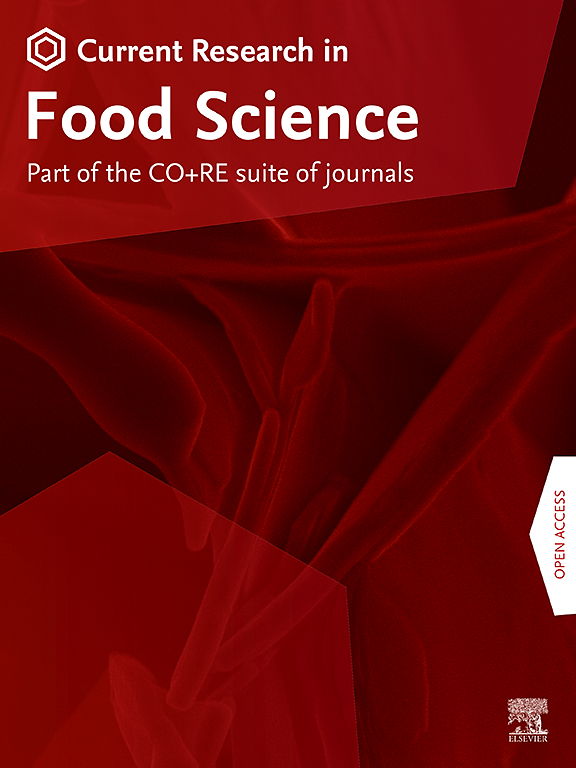Ultrasound-induced modification of pea pod protein concentrate
IF 7
2区 农林科学
Q1 FOOD SCIENCE & TECHNOLOGY
引用次数: 0
Abstract
Agricultural by-products have emerged as valuable resources for the sustainable production of high-quality food ingredients. Ultrasound, a novel and environmentally friendly technology, is an effective physical method for solvent-free protein modifications. This study explores the conversion of pea pods as an agricultural by-product into value-added protein-based food ingredients with multifunctional properties enhanced by high-intensity ultrasound (US). Pea pod protein concentrate in the native form (PPPC-N) obtained by alkaline extraction/isoelectric precipitation was subjected to ultrasound-induced protein modification using response surface methodology at varying amplitude (40–80 %), time (2–20 min), and protein concentration (1–5 % w/v). The US process parameters were separately optimized based on maximum solubility, emulsification, and antioxidant activity. Protein concentrates were characterized at optimal conditions (80 % amplitude, 11 min, and 1 % protein; the desirability of 0.964) based on the maximum emulsification. The optimized PPPC by US (PPPC-US) exhibited a superior solubility performance compared to PPPC-N in the pH range of 2.0–9.0. The optimal US treatment enhanced the emulsifying attributes and foaming capacity of PPPC-N with an increase of 49 %. Moreover, oil binding capacity significantly increased while water binding capacity and foam stability decreased. Developing functional ingredients from pea pod proteins can open new possibilities in formulating innovative products.

豆荚浓缩蛋白的超声改性研究
农业副产品已成为可持续生产高质量食品原料的宝贵资源。超声技术是一种新型的、环保的、有效的无溶剂蛋白质修饰的物理方法。本研究探讨了通过高强度超声(US)将作为农业副产品的豆荚转化为具有多功能特性的增值蛋白食品成分。通过碱性提取/等电沉淀法获得天然形式的豌豆豆荚蛋白浓缩物(PPPC-N),采用响应面法在不同振幅(40 - 80%)、时间(2-20 min)和蛋白质浓度(1 - 5% w/v)下进行超声诱导蛋白修饰。根据最大溶解度、乳化性和抗氧化性分别对美国工艺参数进行了优化。蛋白质浓缩物在最佳条件下(80%振幅,11分钟,1%蛋白质;以最大乳化量为基础,理想值为0.964)。US优化后的PPPC (PPPC-US)在2.0 ~ 9.0的pH范围内比PPPC- n具有更好的溶解性能。最佳的US处理使PPPC-N的乳化性能和发泡能力提高了49%。油的结合力显著提高,水的结合力和泡沫稳定性下降。从豆荚蛋白中开发功能性成分可以为开发创新产品开辟新的可能性。
本文章由计算机程序翻译,如有差异,请以英文原文为准。
求助全文
约1分钟内获得全文
求助全文
来源期刊

Current Research in Food Science
Agricultural and Biological Sciences-Food Science
CiteScore
7.40
自引率
3.20%
发文量
232
审稿时长
84 days
期刊介绍:
Current Research in Food Science is an international peer-reviewed journal dedicated to advancing the breadth of knowledge in the field of food science. It serves as a platform for publishing original research articles and short communications that encompass a wide array of topics, including food chemistry, physics, microbiology, nutrition, nutraceuticals, process and package engineering, materials science, food sustainability, and food security. By covering these diverse areas, the journal aims to provide a comprehensive source of the latest scientific findings and technological advancements that are shaping the future of the food industry. The journal's scope is designed to address the multidisciplinary nature of food science, reflecting its commitment to promoting innovation and ensuring the safety and quality of the food supply.
 求助内容:
求助内容: 应助结果提醒方式:
应助结果提醒方式:


